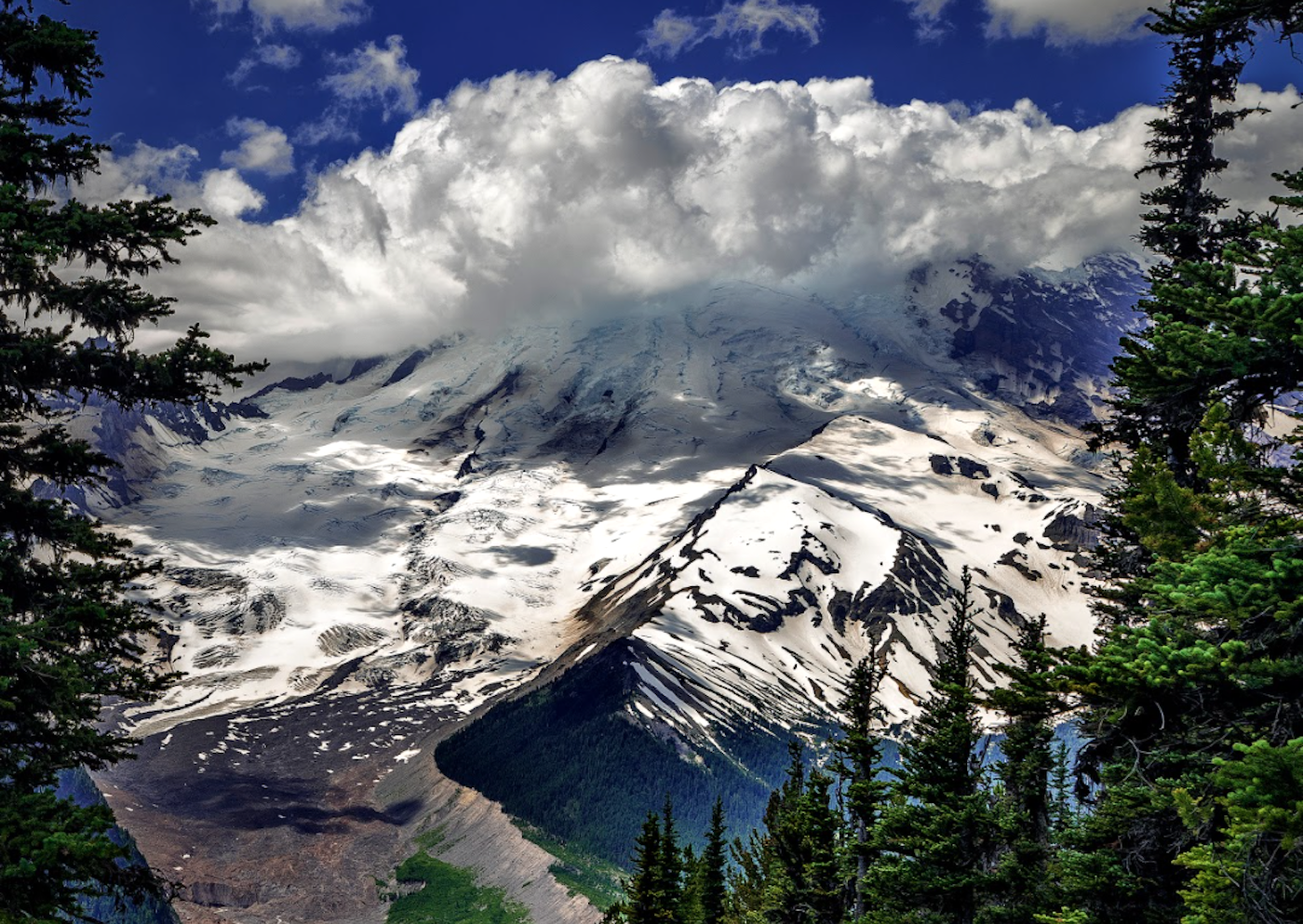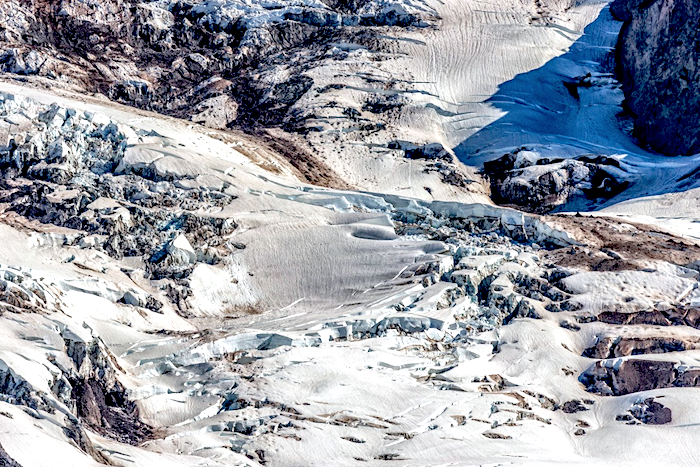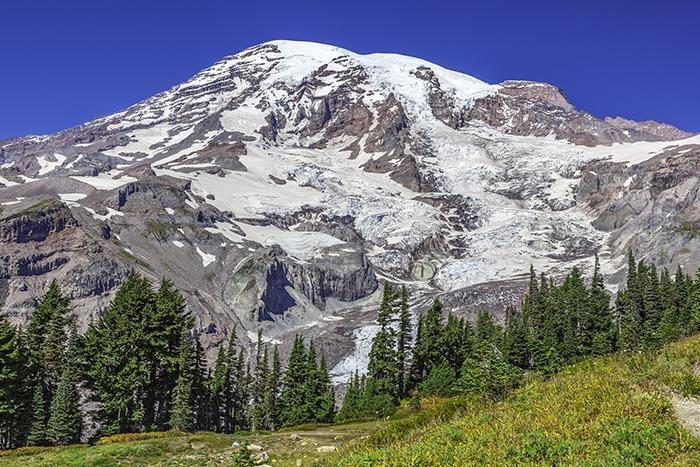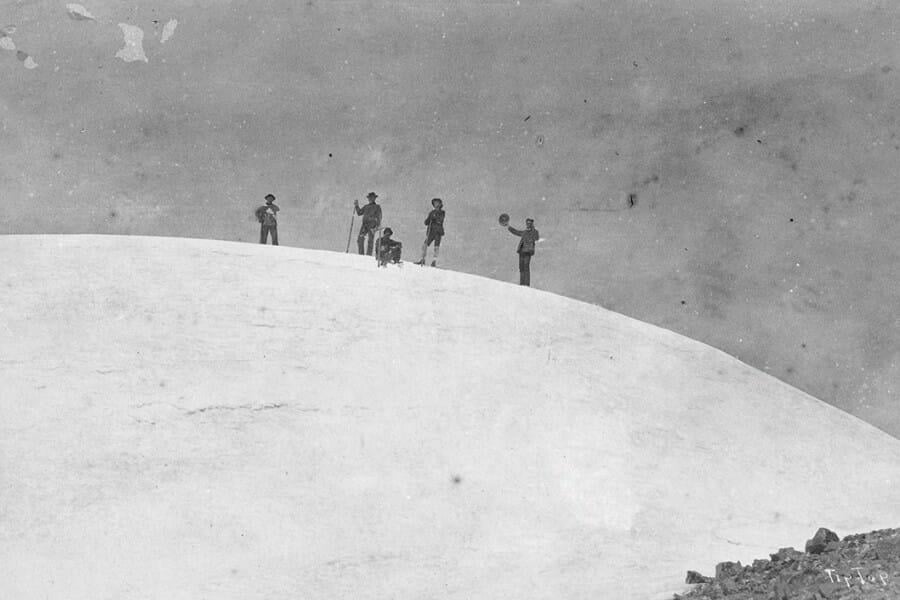
Mount Rainier, Not A Place To Take Lightly
By Rita Beamish
Inching along in the darkness, with only her boot crampons tethering her to the icy mountainside – preventing a steep and perhaps lethal slide -- Natalie Docktor was hyper-aware that “anything could happen.” Mount Rainier, after all, was the graveyard for plenty of climbers before her. “I knew that was a possibility,” she said.
But the 57-year-old Californian, climbing in the summer of 2020 with her 19-year-old son and a commercially guided group, wasn’t dwelling on the scariness as she clung to her determination to press onward. Like more than 10,000 climbers each year, Docktor felt compelled to reach the 14,410 summit of the Cascades titan that dominates the skyline outside of Seattle. Like about half of those, she would make it to the top, where, she recalled, “It was exhilarating.”
Of the hikers who turn back before they can achieve that victory, most make it out safely. Mount Rainier can be deadly, but death is hardly what prevents most from succeeding up the glacier-shrouded volcano. Although climbing carries inherent risks, it’s not how most deaths in the sprawling Mount Rainier National Park occur.

Mount Rainier's rotten snow and ice fields pose dangers to the unfamiliar/Rebecca Latson
Of the 425 fatalities recorded over more than a century -- 1897 to 2017 -- about 90 were summit climbers, in addition to 35 or so climbing accidents that were non-summit related, park data shows. The rest of the deaths run the gamut through the park: the likes of drowning and driving fatalities, day-hiker mishaps, health emergencies, and the 32 Marines whose plane crashed into Rainier’s South Tahoma Glacier in 1946.
“The vast majority of people do not die climbing Mount Rainier,” said Stefan Lofgren, manager of the program of climbing rangers who patrol the mountain and conduct search and rescue. “There are many risks you encounter on a mountain like Mount Rainier, but our culture is such that we have developed an approach to climbers that helps them mitigate those risks.”
Summit climbers in fact account for less than 1% of Mount Rainier National Park’s 1.5 million recreational visitors a year, National Park Service data shows. The vast majority entering the park are day trippers, arriving for driving tours, or to ogle the riot of springtime wildflowers.
Statistics aside, “deaths at Rainier get a lot of press coverage,” the national park’s deputy superintendent Tracy Swartout told the Traveler. Climbing the mountain has year-around risks, she said, adding however, “There is a risk any time of the year and in any activity,” throughout the park’s wilderness environment that challenges visitors on and off the glaciers. “The most important thing is that you are prepared and that you pay attention to conditions, and that you aware of your own ability.”
In fact, the decades are filled with harrowing stories of both day hikers and climbers who succumbed due to lack of preparation, ability or judgment, or experienced mountaineers who fell to Rainier’s unpredictable traps: Rockfall, icefall, avalanches. The opaque blur of a sudden, whiteout blizzard. The depths of an icy crevasse hidden beneath a too-weak snow bridge.
“Mount Rainier is exceptionally beautiful, and it’s a complicated mountain,” in no small part because of its rotten, unstable volcanic rock, said Mike Gauthier, a former longtime climbing ranger and author of the indispensible “Mount Rainier: A Climbing Guide.” “Sometimes people can get in hot water fast.”
The mountain’s towering drama – it has the most glacier mass of any mountain in the lower 48 – and its accessibility to metropolitan dwellers, give it a renowned allure. Mountaineers say it’s a good skill sharpener for the skyscraping giants of Asia and South America, and Alaska’s Denali.
“If you want to become a big mountain climber, this is your first step,” said Mitsu Iwasaki, CEO of the American Alpine Club. “It’s a big mountain. It’s got an iconic shape. It’s heavily glaciated. It’s one of one of those things people train for … one of your first relatively big mountains.”

The Mountain beckons climbers/Rebecca Latson
For outdoor afficionados in the Pacific Northwest, Rainier is the backyard. They can drive over from Seattle in a couple of hours. And with that accessibility comes plenty of opportunity for trouble.
Rainer’s comparable height to Colorado’s fourteeners, and its promise of an up-and-back hike in two-to-four days, tempts many: “They think they can climb it,” said Jonathon Spitzer, field operations director for the guiding company Alpine Ascents. “They underestimate it,” he said. “It’s a different skill set.”
Mike Gauthier’s must-do tips for a successful summit:
- Get in excellent shape.
- Climb in good weather
- Know and have climbed with your teammates.
In short, Mount Rainier is doable but it’s not for the weekend warrior. Rescues above the high camps average about five to 15 a year, but sometimes more, most relating to slips and falls and respiratory problems. Weather often forces poor decisions for the uninitiated, Gauthier said, such as pushing to adhere to a timeline instead of turning around in dangerous weather.
The rangers frequently counsel climbers whose preparedness may not match their ambitions. “The climbers help them make good decisions,” Lofgren said. “We have talked quite a few into doing a crevasse rescue practice, and then coming up to summit later” instead of pushing ahead before they’re ready. Lofgren said commercial guide companies have helped cement a safety-oriented culture; outdoor risk consultant Steve Smith lauded Mount Rainier’s “remarkable climbing rangers and history of rescues and accident prevention, not just reaction.”
Often, however, fatalities seem inexplicable, even random, like the “unfortunate misstep,” described in 2004 ranger records, that toppled an accomplished climber. He struck his head just below his helmet brim, on a rock. Or the 2014 loss of four hikers and two guides apparently swept from their mountain camp by an avalanche or icefall on the Liberty Ridge route.
Another well-prepared climber died when he fell into a crevasse on Liberty Ridge, Gauthier recalled, on the same day that Gauthier’s partner had fallen into the same treacherous slot but managed to get out: The mountain gives and takes.
Yet another occasion found Gauthier and his friend Sally Jewell, who would later become secretary of the Interior, in a sudden storm on a day hike to Camp Muir, the 10,080-foot gateway to south-side summit routes. They’d met a pair of day hikers enroute. “The weather became ferocious, the classic Mount Rainier,” Gauthier said. He and Jewell had to abandon their plan to snowboard down from Camp Muir and walk down instead using GPS. The other two hikers never came down. They were found the next day frozen to death.
The Mount Rainier Climbing website, hosted by the climbing rangers, gave a window into Rainier’s volatility in a Sept. 26 warning:
“Dangerous conditions currently exist on the mountain with crevasses on the lower slopes being just barely covered with this new blanket of snow,” the website said. “Be prepared to rope-up: have helmets, harnesses, ice axes, crampons, pickets and other glacier travel equipment with you -- just to travel to Camp Muir!,”
Earlier that same week, a 27-year-old man had died after becoming disoriented in white-out conditions as he came down from Camp Muir in heavy rain and winds.
This year also saw the death of a Seattle hiker who went missing in tennis shoes and shorts when June snow blanketed the Paradise visitor center area where he’d left his car. His body was found weeks later in a nearby drainage. On a sunny day, he’d have been almost visible from the civilization of Paradise, said Swartout.
“That’s the thing I’m most concerned about, people out for a day hike and misunderstanding the conditions,” she said.

"Ambitious climbers, seeking adventures and opportunities to test their strength and skill, occasionally attempt to penetrate the wilderness on the west side of the Sound, and push on to the summit of Mount Olympus. But the grandest excursion of all to be made hereabouts is to Mount Rainier, to climb to the top of its icy crown. The mountain is very high, fourteen thousand four hundred feet, and laden with glaciers that are terribly roughened and interrupted by crevasses and ice cliffs. Only good climbers should attempt to gain the summit, led by a guide of proved nerve and endurance." -- John Muir, An Ascent of Mount Rainier/John Muir and his climbing party at the summit of Mount Rainier, 1888. UNIVERSITY OF WASHINGTON LIBRARIES, SPECIAL COLLECTIONS, WARNER 712E
Day hikers out of 5,400-foot elevation Paradise share the trail with summit-bound climbers below Camp Muir, but typically are less prepared for dramatic weather shifts or alert to sketchy situations like rushing ice melt and holes hidden beneath thin snow cover, Swartout noted.
Rainier mountaineering “can have a very thin line between an enjoyable walk in the snow and having these challenges that people may be unprepared to recognize and manage. It’s unbelievable how quickly you can go from a nice sunny day to lightning and hail in August,” said Steve Smith, founder of Experiential Consulting, which provides risk management consulting for outdoor programs. “If you are just out on a day hike with your buddies and you get lost up there, you can get out of the more normal snow pack and get into terrain with glaciers, steeper sections and crevasses.”
Team responsibility should not be underestimated either, experts say. A 51-year-old day hiker died after falling behind his large hiking group in a whiteout on Muir Snowfield 16 years ago, the records show. The group kept descending, not checking on him until they reached Paradise. A chopper pilot spotted his body months later in an icefall at 8,100 feet.
For Docktor, this year marked her second summit try. Her stamina gave out last year. That failed attempt informed her on the conditioning, diet, mental preparation and acclimatizing she needed this time around. “You have to be fit and mentally tough,” she said. “It’s not just something like ‘I think I can do it.’”
Topping the edge of the crater was a wonderful feeling, she recalled. “I didn’t know I was crying until I walked down into the crater … It was a tremendous challenge and I loved it.”
Jonathon Spitzer’s pitfalls
- Lack of navigation, glacier travel and tool skills -- and failure to recognize that lack
- Lack of understanding of glaciology, mountaineering and techniques like crevasse rescue
- Underestimating the size of the mountain

Add comment